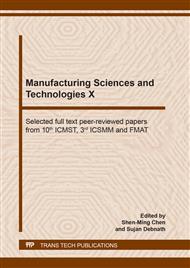p.139
p.147
p.154
p.163
p.169
p.178
p.185
p.191
p.198
Simulation Based Mold Design Optimization of a Spring Flap Casting
Abstract:
The complex nature of metal casting process brings about a need to simulate it before undertaken in a foundry. Casting simulations provide insights on flow of molten metal within the mold, solidification sequence, nature and location of defects etc. Moreover, mold design can be optimized to minimize defects without undergoing physical trials-and-errors as previously practiced in traditional metal casting. This study is based on casting an ASTM A216 WCB steel spring flap for automotive suspension system using a simulation based optimized mold design. The initial and optimized mold designs are simulated in MAGMASoft for mold filling, solidification, stress distribution and defects prediction. The results of simulations and actual castings are found to be in good agreement. It is concluded that simulations are accurate in modeling casting process and in predicting defects followed by their minimization through mold design optimization. The use of auxiliary components in a carefully designed mold can lead to a nearly defect-free and high quality cast product.
Info:
Periodical:
Pages:
178-184
Citation:
Online since:
June 2020
Authors:
Keywords:
Price:
Сopyright:
© 2020 Trans Tech Publications Ltd. All Rights Reserved
Share:
Citation:


